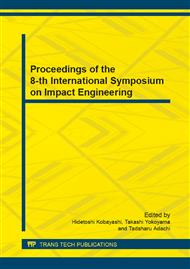p.256
p.262
p.268
p.274
p.281
p.286
p.292
p.298
p.305
Dynamic Fragmentation Tests of LY12 Aluminum Alloy Using a SHPB Based Expanding Ring Technique
Abstract:
A new experimental technology based on the Split Hopkinson Pressure Bar (SHPB) is developed for conducting expanding ring tests. The technique is useful for the studies of the dynamic tensile deformation and the fracture (fragmentation) properties of ductile metallic materials. The loading fixture includes a hydraulic cylinder filled with the incompressible fluid, which is pushed by a piston connected to the input bar. As the liquid is driven, it transfers the pressure to the specimen, compressing and expanding the metallic ring specimen in the radial direction. The approximately incompressible property of the liquid makes it possible to transfer a relatively low piston-driving velocity to a very high radial-expansion velocity of the specimen, as the sectional area of the cylinder narrows significantly. Using this experimental technology the ring specimens made of LY12 aluminum alloy were dynamically expanded and fragmentized. Results show apparent increases of the fragment numbers and fracture strain of the specimen with the increase of the impact velocity. The recovered ring fragments were examined and measured to obtain the average fragment sizes (lengths) during each test. These fragment sizes were compared with the estimates from the classical fragmentation theory that was initiated by N.F. Mott and later developed by D.E. Grady. It was found that the Mott-Grady theory provides reasonably good predictions of the fragment sizes for ductile materials. This conclusion agrees with the recent findings of ours based on the numerical simulations and physical arguments.
Info:
Periodical:
Pages:
281-285
Citation:
Online since:
June 2014
Authors:
Keywords:
Price:
Сopyright:
© 2014 Trans Tech Publications Ltd. All Rights Reserved
Share:
Citation:


